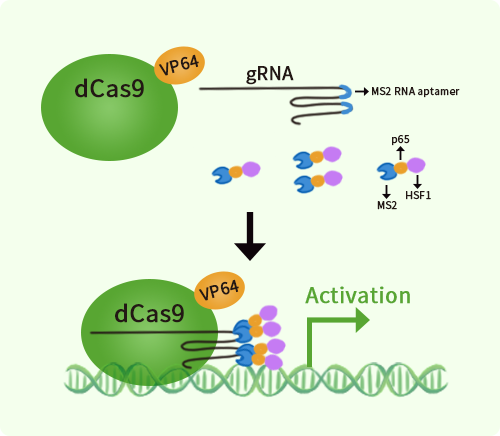Mouse Tex264 activation kit by CRISPRa
CAT#: GA204305
Tex264 CRISPRa kit - CRISPR gene activation of mouse testis expressed gene 264
Find the corresponding CRISPRi Inhibitor Kit
USD 1,657.00
2 Weeks*
Specifications
| Product Data | |
| Format | 3 gRNAs (5ug each), 1 scramble ctrl (10ug) and 1 enhancer vector (10ug) |
| Symbol | Tex264 |
| Locus ID | 21767 |
| Kit Components | GA204305G1, Tex264 gRNA vector 1 in pCas-Guide-GFP-CRISPRa GA204305G2, Tex264 gRNA vector 2 in pCas-Guide-GFP-CRISPRa GA204305G3, Tex264 gRNA vector 3 in pCas-Guide-GFP-CRISPRa 1 CRISPRa-Enhancer vector, SKU GE100056 1 CRISPRa scramble vector, SKU GE100077 |
| Disclaimer | These products are manufactured and supplied by OriGene under license from ERS. The kit is designed based on the best knowledge of CRISPRa SAM technology. The efficiency of the activation can be affected by many factors, including nucleosome occupancy status, chromatin structure and the gene expression level of the target, etc. |
| Reference Data | |
| RefSeq | NM_001081654, NM_001286498, NM_011573, NR_104459 |
| UniProt ID | E9Q137 |
| Synonyms | TEG-264 |
| Summary | Major reticulophagy (also called ER-phagy) receptor that acts independently of other candidate reticulophagy receptors to remodel subdomains of the endoplasmic reticulum into autophagosomes upon nutrient stress, which then fuse with lysosomes for endoplasmic reticulum turnover. The ATG8-containing isolation membrane (IM) cradles a tubular segment of TEX264-positive ER near a three-way junction, allowing the formation of a synapse of 2 juxtaposed membranes with trans interaction between the TEX264 and ATG8 proteins. Expansion of the IM would extend the capture of ER, possibly through a 'zipper-like' process involving continued trans TEX264-ATG8 interactions, until poorly understood mechanisms lead to the fission of relevant membranes and, ultimately, autophagosomal membrane closure. Also involved in the repair of covalent DNA-protein cross-links (DPCs) during DNA synthesis: acts by bridging VCP/p97 to covalent DNA-protein cross-links (DPCs) and initiating resolution of DPCs by SPRTN.[UniProtKB/Swiss-Prot Function] |
Documents
| Product Manuals |
| FAQs |
| SDS |
Resources
Other Versions
| SKU | Description | Size | Price |
|---|---|---|---|
| KN517442 | Tex264 - KN2.0, Mouse gene knockout kit via CRISPR, non-homology mediated. |
USD 1,657.00 |
{0} Product Review(s)
Be the first one to submit a review






























































































































































































































































 Germany
Germany
 Japan
Japan
 United Kingdom
United Kingdom
 China
China
